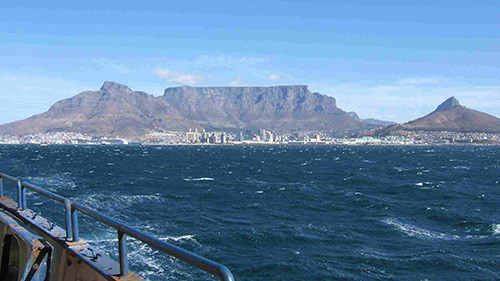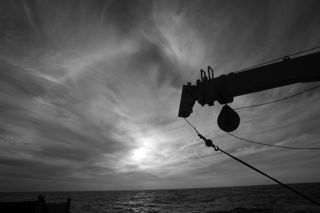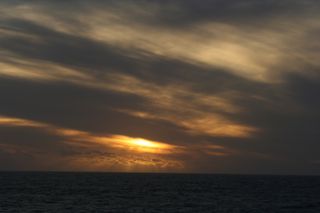
It’s 6:15 on Easter Sunday morning, and the ship is still quiet, but not for long. This is departure day. Even now I hear people beginning to stir. Soon her scientists, technicians, and crew people will be attending to final preparations for sea. If all goes according to plan, we’ll be underway from Duncan Dock in Cape Town, South Africa by noon.
Knorr is designed for and dedicated solely to ocean research (doing so, she’s logged well over one million miles in every ocean on the planet). So of course in the next twenty days we’ll be discussing oceanography, the science of the sea, in our daily journals on this website. We’ll also tell you about day-to-day life aboard this fine old ship, the one, by the way, that discovered the Titanic. But the reason we’ve gathered here in Cape Town from three continents is to investigate a major Indian Ocean current called the Agulhas. We’ll be talking much more about the Agulhas, it’s behavior, significance, its relationship to the rest of the Indian Ocean and to the other oceans of the world—and ultimately to our climate. We’ll talk also about just how and why ocean scientists go about investigating and measuring their subject. The work aboard Knorr is a unique combination of advanced technology and traditional seamanship performed around the clock in all weathers by some of the best scientists, technicians, and sailors in the world.

Wait, I feel the engines rev. We’re pulling away from the wharf, and the Cape Town Harbor pilot has just come aboard. This a lovely town in a magnificent natural setting at the foot of Table Mountain, and we’ve all enjoyed our brief visit, but now the time has come to leave it for the open sea. The day is crisp and crystalline, but a stiff wind has gotten up to about 40 knots with higher gusts, white caps in the harbor. Derek, our second mate, is on the helm, Captain Kent vigilant on the starboard bridge wing, when the harbor pilot calls for us to wait while a fuel ship enters the breakwaters at the mouth of the harbor. It looks to me to be a bit difficult to keep our bow steady in the breeze, but this is routine stuff for these pros.
Captain Kent hears a radio call from a massive, multi-decked cruise ship lying to the wharf we’ve just left. Three of her dock lines have parted, and her bow his swung fifteen meters from the wharf. The cruise-ship captain wants a tug to push her back. Anyway, she won’t be allowed to sail today, the pilot says, too rough for the likes of them. It’s a little surprising for those of us from the other hemisphere to see this much wind on a fine, cloudless day. As a small-boat sailor, I was hoping to steer to get the feel of a ship; clearly, however, these are not the best conditions for beginners to practice.
We’re clear of the harbor now, in the main channel, and the pilot, an easy-going, jovial fellow, calls for his boat to come alongside. I escort him down three decks to the starboard rail, where his boat is keeping pace with Knorr. By the time I climb back up to the bridge, we feel the distinct swell of open ocean. It’s nice. It’s a good place to be.

As you already know if you’ve read the introduction to our website, Dr. Lisa Beal is our chief scientist, which is to say that this is her trip. Her grant from the National Science Foundation is paying for the cruise. An expert on the Agulhas Current, she has chosen a line some 150 miles long on the east side of South Africa, where she means to place a string of instruments picket-fence fashion astride the flow from the surface to the bottom. That’s where we’re heading now, a two-day steam from Cape Town, toward the inshore end of the line. Her instruments will remain in the water for eighteen months measuring the velocity and volume of water transported by the Agulhas Current. After that time, she will return to the line, retrieve the instruments, collect their data, re-deploy the instruments for total study period of three years. We’ll talk tomorrow about why she wants to measure the Agulhas, how she and her science staff will do so, and about why it’s important for the rest of us that scientists understand the nature of this and other such currents coursing like giant blood vessels through the body of the world ocean. But for today, let’s put it simply: Dr. Lisa is seeking to understand how our world works; that’s what scientists do. It’s just that ocean scientists do it from ships, and one way or another, as we’ll see, all of us benefit from their efforts.
The wind is down now as darkness falls on this our first day at sea. The ship feels stable, comfortable, pleased to be back in her element, but then, I’ll admit, I’m an ocean romantic. Good evening to you all and welcome aboard.






